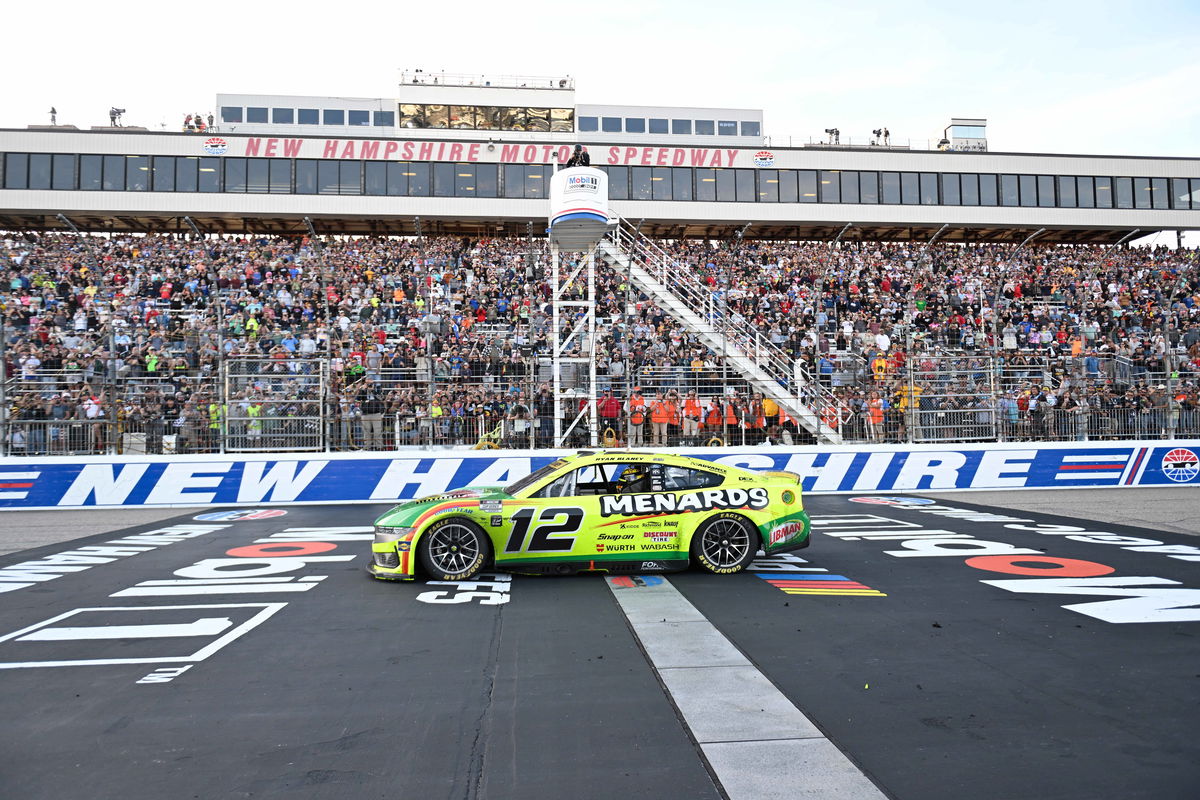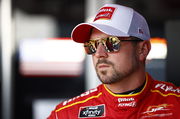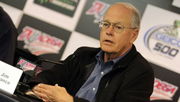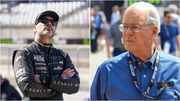
Imago
NASCAR, Motorsport, USA NASCAR Cup Series Race at New Hampshire Sep 21, 2025 Loudon, New Hampshire, USA NASCAR Cup Series driver Ryan Blaney 12 parks his car on the finish line after winning the Mobil 1 301 at New Hampshire Motor Speedway. Loudon New Hampshire Motor Speedway New Hampshire USA, EDITORIAL USE ONLY PUBLICATIONxINxGERxSUIxAUTxONLY Copyright: xEricxCanhax 20250921_sjb_qe2_051

Imago
NASCAR, Motorsport, USA NASCAR Cup Series Race at New Hampshire Sep 21, 2025 Loudon, New Hampshire, USA NASCAR Cup Series driver Ryan Blaney 12 parks his car on the finish line after winning the Mobil 1 301 at New Hampshire Motor Speedway. Loudon New Hampshire Motor Speedway New Hampshire USA, EDITORIAL USE ONLY PUBLICATIONxINxGERxSUIxAUTxONLY Copyright: xEricxCanhax 20250921_sjb_qe2_051
The TV numbers aren’t painting a pretty picture. When NASCAR rolled into New Hampshire Motor Speedway recently, the expectations were high. After all, the Round of 12 had officially begun, and the stakes were higher than they’ve ever been. But despite the magnitude of the event, only 1.29 million viewers tuned in to USA Network, with the race getting a lowly 0.70 rating. That’s a sharp decline from 1.88 million viewers and a 1.0 rating for the same event last year. But what’s the reason behind this slump?
Watch What’s Trending Now!
Back in 2024, NASCAR viewership showed a consistent upward trajectory. The season averaged around 2.892 million viewers per event, with the regular-season viewership increasing by 1% and that figure rising to 5% during the playoffs. It seems like the 2025 Mobil 1 301 was an anomaly of sorts, especially with the Las Vegas race in spring, and the Bristol race earlier this year posted strong viewership numbers. Does it indicate a deeper issue?
ADVERTISEMENT
Regional Relevance Fading?
New Hampshire is located in the Northeast, a legacy market for NASCAR, along with the Southeast and the Midwest. But the empty seats and dwindling viewership indicate that the sport might be losing traction where it once thrived. The attendance in the grandstands isn’t showing positive figures either, which might be because many long-term fans feel disconnected from the sport that seems to have strayed away from its roots.
Even local media coverage for NASCAR is thinning, with newspapers carrying fewer weekly columns and post-race recaps. Blame it on the playoff structure, fans ageing out, or simply cable television being on the decline, it’s pretty evident that the stock car racing series is losing relevance in a market where it was once strong, proving that ‘legacy’ can only take you so far when it comes to prioritizing the very supporters who made the sport great.
Top Stories
‘RIP’: NASCAR World Crumbles in Tears as 39-YO Former JR Motorsports Driver Passes Away

Dale Jr’s Former Driver’s Death Devastates NASCAR Garage as Brad Keselowski Shares Heart-Ripping Tribute

55-YO NASCAR Driver’s Untimely Death Shatters Racing Community

France Family’s ‘Financial Deception’ Spilled Out in the Open as RTA Memo Exposes the ‘49%’ Lie

Jimmie Johnson & Co. Robbed of Millions as Court Exposes Disastrous Fallout of Jim France’s ‘No Bueno’ Decision

ADVERTISEMENT
Is the Format Wearing Thin?
The criticism has been constant. Many fans feel that the midseason races have been too flat, with long green flag runs, fewer cautions, and not enough drama. Stock car racing enthusiasts seem to have had enough of the playoff structure as well, with stage racing and points adding a layer of complexity that makes it difficult to follow, while the ‘win and in’ format reduces the emotional investment for fans, especially when clutch results are rewarded more than consistency throughout the year.
According to NASCAR content creator Eric Estepp, “Cable subscriptions hit a new low every year,” even though there are more Cup Series races on cable networks than ever before. He also said that “20-year-olds aren’t watching cable or sitting through 3+ hour races,” highlighting a clear disconnect for the younger fans, which might be an underlying reason behind falling numbers. With the sport having six more years remaining on the existing media rights agreement, it’s clear that NASCAR isn’t well-positioned to adapt to the changing viewership habits.
ADVERTISEMENT
Broadcast & Promotion Gaps
It’s not just about what’s happening on track, but how NASCAR is selling its content as well. Ever since the sanctioning body signed the multi-billion-dollar media rights agreement, they’ve been juggling multiple broadcast platforms, including cable and streaming (Amazon Prime). This is confusing fans, many of whom can’t keep up with the ever-changing schedule across networks, or even subscribing to a streaming service simply to watch races.
In contrast, the likes of Formula 1 and even IndyCar are adopting a different approach. They’re selling the series by focusing on driver rivalries, engaging fans in a storytelling format, and even sharing behind-the-scenes content. Having a Netflix show as popular as the ‘Drive to Survive’ series helps as well. FOX has been leaving no stone unturned to promote IndyCar this year, sharing videos on social media, while Roger Penske is making sure there are plenty of trackside activations to keep fans engaged.
ADVERTISEMENT
In comparison, NASCAR seems to be doing very little to promote the sport. Sure, you’ll see the one-off advertisement on cable networks, but they lack a thematic consistency or a budget to keep fans hooked. The result is the numbers we have seen at New Hampshire Motor Speedway, with a significant decline in viewership on screens, while the grandstands show more empty seats than ever before.
What are fans feeling?
NASCAR fans are frustrated, and rightly so. They feel unheard and unloved, especially after the sanctioning body has spent years doing things its own way. Many aren’t buying into the playoff format, with a recent poll by Mark Martin highlighting that 60% of fans wanted the sport to revert to the ‘Classic 36 race season’. And while the sport is looking to expand with the inclusion of road course races, Shane van Gisbergen’s utter dominance on such tracks is making the sport predictable.
ADVERTISEMENT
Fans want to feel more invested, and the current playoff structure isn’t doing the job. Ryan Blaney’s triumph at New Hampshire highlighted Team Penske’s dominance in a high-stakes race, just like last year and in 2023. Many feel that the broadcast coverage is flat and uninteresting, which might explain why fans are tuning out, even in markets that NASCAR could traditionally rely on.
So, what needs to change?
NASCAR has its work cut out for it. They don’t just need to get new viewers, but retain the old ones, and that might need a big shift in strategy. First, it’s TV, and the distribution approach must be in line with how younger viewers consume motorsports. If more races shift to a hybrid or a streaming model, the sanctioning body can ensure better quality control, more revenue, and better cross-platform promotional material to lure more casual fans in.
ADVERTISEMENT
Of course, that’s a double-edged sword. NASCAR’s demographic has traditionally been older fans, many of whom don’t have access or familiarity with streaming services. It will also price out a section of the fanbase who are unwilling to shell out the subscription fee for a service like Amazon Prime. The sport will also need to have more diversity on the calendar, as too many ‘cookie-cutter’ events are a sure-shot way of fans losing interest.
Perhaps a mix of short-tracks, road courses, and newer venues will add a freshness to the calendar, and track-specific narratives need to be marketed well to ensure fans are excited to tune in. NASCAR also needs to work on building more on-track rivalries, covering more off-track dynamics, and featuring team conflicts, even if it’s just a radio exchange. It needs to give fans a reason to tune into the action next week and feel emotionally invested in their favorite driver’s journey.
It also needs to raise the stakes in the middle of the season. The In-Season Challenge is a step in the right direction, as it gives fans a reason to tune in for the ‘less important’ races. If every fixture has a consequence, fans have more reasons to tune in every weekend. Lastly, broadcasting needs to be unified in its approach. Perhaps NASCAR can take a leaf out of Formula 1 or IndyCar’s book and build every race as an event, and not just another fixture on the schedule.
ADVERTISEMENT
Conclusion – A Signal, Not Just a Stat
New Hampshire’s ratings and viewership numbers aren’t a one-off; it’s a warning. NASCAR is at a serious risk of losing its fanbase, especially if it doesn’t get its act together to give supporters a reason to stay. If the sport can reconnect with what fans emotionally want, it might be able to salvage the situation. There’s no room for complacency, and the stock car racing series can’t rely solely on legacy and goodwill. Otherwise, results like those in New Hampshire won’t be the exception, but the norm.
ADVERTISEMENT
ADVERTISEMENT
ADVERTISEMENT

